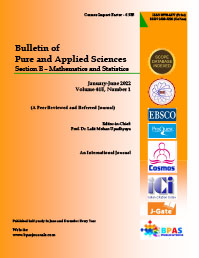ECONOMIC ORDER QUANTITY MODEL WITH PRODUCTION PLAN FOR SEQUENTIALLY CONVERTIBLE ITEM
DOI:
https://doi.org/10.48165/Keywords:
Inventory, Sequentially Convertible item, Conversion cost, Conversion timeAbstract
An economic quantity and production plan is developed for sequentially convertible items for deteriorating items. The initial form of an item sequentially converts into another form and different nature of items. In this process conversion cost and times need to convert the item. We have considered that demand of an item is different for different converted items, also the deterioration rates are different. For example, milk is converted into curd, curd into butter and butter into ghee after different durations of time. Managerial insights are provided for convertible items. Conversion of items needs conversion cost and conversion time.
References
. Harris, F.W. (1915). What quantity to make at once the library of factory management, Operations and Costa (A. W. Shaw Company, Chicago), 5, 47-52.
. Shukla, D. and Khedlekar, U. K. (2016). Inventory model for convertible item with deterioration, Communications in Statistics—Theory and Methods, 45(4), 1137-147.
. Shukla, D., Khedlekar, U.K., Chandel, R.P.S. and Bhagwat, S. (2012). Simulation of inventory policy for product with price and time-dependent demand for deteriorating item, International Journal of Modeling, Simulation, and Scientific Computing, 3(1), 1-30.
. Mabini, M.C. and Gelders, L.F. (1990). Repairable item inventory system: A literature review, Belgian Journal of Operations Research, Statistics and Computer Science, 30, 57-69.
. Federgruen, A. and Heching, A. (1999). Combined pricing and inventory controlled under uncertainly, Operations Research, 47, 454-475.
. Hellweg, S., Hofsteller, T. B. and Hungerbuhler, K. (2001). Modeling waste incineration for life-cycle inventory analysis in Switzerland, Environment Modeling and Assessment, 6(4), 219-235. [7]. Matsumaya, K. (2001). The general EOQ model with increasing demand costs, Journal of Operation [8]. Silver, E. and Moon, I. (2001). The multi-item single period problem with an initial stock of convertible units, European Journal of Operational Research, 132(2), 466-477.
. Chu, Y.H. (2003). Optimal pricing and ordering policies for perishable commodities, European Journal of Operational Research, 144, 68-82.
. You, S.P. (2005). Inventory policy for products with price and time-dependent demands, Journal of Operations Research Society, 56(7): 870-873.
. Chena, C. K., Hungb, T.W. and Wenga, T.C. (2007). Optimal replenishment policies with allowable shortages for a product life-cycle, Computers and Mathematics with Application, 53(10), 1582-1594. [12]. Chung, C.J. and Wee, H.M. (2009). An inventory deteriorating model for short life-cycle green product
remanufacturing, 6th Australia Conference on Life- Cycle Assessment, Melbourne, Australia, February,16-[22]. 19, 2009.
. Khedlekar, U.K. and Agrawal, R.K. (2009). A deterministic order level inventory model for two types of deteriorating items with three storage facility, Reflection Des Era (RDE), 5(1), 201-208. [14]. Moon, I.K., Hahm, J. and Lee, C. (2010). The effects of inflation and time value of money on a production model with a random product life cycle, Asia-Pacific Journal of Operational Research, 27(4), 437-456.
. Shukla, D., and Khedlekar, U.K. (2010). An order level inventory model with three-component demand rate (TCDR) for newly launched deteriorating item, International Journal of Operations Research, 7(2), 61-70.
. Hsueh, C.F. (2011). An inventory control model with consideration of remanufacturing and product life-cycle, International Journal of Production Economics, 133(2), 645-652.
. Khedlekar, U. K. and Shukla, D. (2014). Inventory model for convertible item with deterioration, Communications in Statistics—Theory and Methods, 45(4), 1134-147.
. Teng, J.T. & Chang C.T. (2005). Economic production quantity model for deteriorating items with price and stock dependent demand. Computer & Operations Research, 32(2), 297-308. [19]. Qi, X., Bard, J.F. & Yu, G. (2004). Supply chain coordination with demand disruptions. Omega, 32(4), 301-312.
. Yang, J., Qi, X, & Yu, G. (2005). Disruption management in production planning. Naval Research Logistic, 52(5), 420-442.
. Samanta, G.P. & Roy, A.A. (2004). Production inventory model with deteriorating items and shortages. Yugoslav Journal of Operations Research, 14(2), 219-230.
. Chandel, R.P.S. & Khedlekar U.K. (2013). A new inventory model with multiple warehouses. International Research Journal of Pure Algebra Research, 3(5), 192-200.
. Kumar, R. & Sharma, S.K. (2012). Formulation of product replacement policies for perishable inventory systems using queuing theoretic approach. American Journal of Operational Research, 2(4), 27-30.
